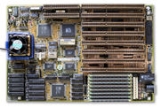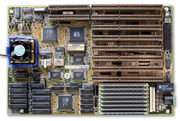
AT form factor
Encyclopedia
In the area of IBM compatible personal computer
s, the AT form factor referred to the dimensions and layout (form factor
) of the motherboard
for the IBM AT. Like the IBM PC
and IBM XT models before it, many third-party manufacturers produced motherboards compatible with the IBM AT form factor, allowing end users to upgrade their computers for faster processors. The IBM AT became a widely copied design in the booming home computer market of the 1980s. IBM clone
s made at the time began using AT compatible designs, contributing to its popularity. In the 1990s many computers still used AT and its variants. Since 1997, the AT form factor has been largely supplanted by ATX
.
, later known as "Full AT", is 12 inches (305 mm) wide and 13.8 inches (350 mm) deep, which means it will not fit in "mini desktop" or "minitower cases". The board's size also means that it takes up space behind the drive bay
s, making installation of new drives more difficult. (In IBM's original heavy-gauge steel case, the two 5-1/4" full-height drive bays overhang the front of the motherboard. More precisely, the left bay overhangs the motherboard, while the right bay is subdivided into two half-height bays and additionally extends downward toward the bottom of the chassis, allowing a second full-height fixed disk to be installed below a single half-height drive.)
The power connectors for AT motherboards are two nearly identical 6-pin plugs and sockets. As designed by IBM, the connectors are mechanically keyed so that each can only be inserted in its correct position, but some clone manufacturers cut costs and used unkeyed (interchangeable) connectors. Unfortunately, the two power connectors it requires are not easily distinguishable, leading many people to damage their boards when they were improperly connected; when plugged in, the two black wires on each connector must be adjacent to each other, making a row of 4 consecutive black wires (out of the total 12). Technicians developed mnemonic devices to help assure proper installation, including "black wires together in the middle" and "red and red and you are dead."
 In 1985 IBM
In 1985 IBM
introduced Baby AT and soon after all computer makers abandoned AT for the cheaper and smaller Baby AT form factor, using it for computers that spanned several generations, from those that used 286 processors to the first Pentiums. These motherboards have similar mounting hole positions and the same eight card slot locations as those with the AT form factor, but are 2" (51 mm) narrower and marginally shorter. The size (220x330 mm) and flexibility of this kind of motherboard were the key to success of this format. The development of bigger CPU coolers -- and the fact that they blocked full-length PCI and ISA cards -- spelled the end of Baby AT and was the main impetus for its successor ATX
. While now mostly obsolete, a few computers are still use it and some modern PC cases are backwards compatible.
In 1995, Intel introduced ATX
, a form factor which gradually replaced older Baby AT motherboards. During the late 1990s, a great majority of boards were either Baby AT or ATX. Many motherboard manufacturers favored Baby AT over ATX as many computer cases and power supplies in the industry were still designed for AT boards and not ATX boards. Also, the lack of an eighth slot on ATX motherboards kept it from being used in some servers. After the industry shifted to ATX motherboard configurations, it became common to design cases and power supplies to support both Baby AT and ATX motherboards.
Personal computer
A personal computer is any general-purpose computer whose size, capabilities, and original sales price make it useful for individuals, and which is intended to be operated directly by an end-user with no intervening computer operator...
s, the AT form factor referred to the dimensions and layout (form factor
Comparison of computer form factors
In computing, a form factor specifies the physical dimensions of major system components. Specifically, in the IBM PC compatible industry, standard form factors ensure that parts are interchangeable across competing vendors and generations of technology, while in enterprise computing, form factors...
) of the motherboard
Motherboard
In personal computers, a motherboard is the central printed circuit board in many modern computers and holds many of the crucial components of the system, providing connectors for other peripherals. The motherboard is sometimes alternatively known as the mainboard, system board, or, on Apple...
for the IBM AT. Like the IBM PC
IBM PC
The IBM Personal Computer, commonly known as the IBM PC, is the original version and progenitor of the IBM PC compatible hardware platform. It is IBM model number 5150, and was introduced on August 12, 1981...
and IBM XT models before it, many third-party manufacturers produced motherboards compatible with the IBM AT form factor, allowing end users to upgrade their computers for faster processors. The IBM AT became a widely copied design in the booming home computer market of the 1980s. IBM clone
IBM PC compatible
IBM PC compatible computers are those generally similar to the original IBM PC, XT, and AT. Such computers used to be referred to as PC clones, or IBM clones since they almost exactly duplicated all the significant features of the PC architecture, facilitated by various manufacturers' ability to...
s made at the time began using AT compatible designs, contributing to its popularity. In the 1990s many computers still used AT and its variants. Since 1997, the AT form factor has been largely supplanted by ATX
ATX
ATX is a motherboard form factor specification developed by Intel in 1995 to improve on previous de facto standards like the AT form factor. It was the first big change in computer case, motherboard, and power supply design in many years, improving standardization and interchangeability of parts...
.
Design
The original AT motherboardMotherboard
In personal computers, a motherboard is the central printed circuit board in many modern computers and holds many of the crucial components of the system, providing connectors for other peripherals. The motherboard is sometimes alternatively known as the mainboard, system board, or, on Apple...
, later known as "Full AT", is 12 inches (305 mm) wide and 13.8 inches (350 mm) deep, which means it will not fit in "mini desktop" or "minitower cases". The board's size also means that it takes up space behind the drive bay
Drive bay
A drive bay is a standard-sized area for adding hardware to a computer. Most drive bays are fixed to the inside of a case, but some can be removed....
s, making installation of new drives more difficult. (In IBM's original heavy-gauge steel case, the two 5-1/4" full-height drive bays overhang the front of the motherboard. More precisely, the left bay overhangs the motherboard, while the right bay is subdivided into two half-height bays and additionally extends downward toward the bottom of the chassis, allowing a second full-height fixed disk to be installed below a single half-height drive.)
The power connectors for AT motherboards are two nearly identical 6-pin plugs and sockets. As designed by IBM, the connectors are mechanically keyed so that each can only be inserted in its correct position, but some clone manufacturers cut costs and used unkeyed (interchangeable) connectors. Unfortunately, the two power connectors it requires are not easily distinguishable, leading many people to damage their boards when they were improperly connected; when plugged in, the two black wires on each connector must be adjacent to each other, making a row of 4 consecutive black wires (out of the total 12). Technicians developed mnemonic devices to help assure proper installation, including "black wires together in the middle" and "red and red and you are dead."
Variants

IBM
International Business Machines Corporation or IBM is an American multinational technology and consulting corporation headquartered in Armonk, New York, United States. IBM manufactures and sells computer hardware and software, and it offers infrastructure, hosting and consulting services in areas...
introduced Baby AT and soon after all computer makers abandoned AT for the cheaper and smaller Baby AT form factor, using it for computers that spanned several generations, from those that used 286 processors to the first Pentiums. These motherboards have similar mounting hole positions and the same eight card slot locations as those with the AT form factor, but are 2" (51 mm) narrower and marginally shorter. The size (220x330 mm) and flexibility of this kind of motherboard were the key to success of this format. The development of bigger CPU coolers -- and the fact that they blocked full-length PCI and ISA cards -- spelled the end of Baby AT and was the main impetus for its successor ATX
ATX
ATX is a motherboard form factor specification developed by Intel in 1995 to improve on previous de facto standards like the AT form factor. It was the first big change in computer case, motherboard, and power supply design in many years, improving standardization and interchangeability of parts...
. While now mostly obsolete, a few computers are still use it and some modern PC cases are backwards compatible.
In 1995, Intel introduced ATX
ATX
ATX is a motherboard form factor specification developed by Intel in 1995 to improve on previous de facto standards like the AT form factor. It was the first big change in computer case, motherboard, and power supply design in many years, improving standardization and interchangeability of parts...
, a form factor which gradually replaced older Baby AT motherboards. During the late 1990s, a great majority of boards were either Baby AT or ATX. Many motherboard manufacturers favored Baby AT over ATX as many computer cases and power supplies in the industry were still designed for AT boards and not ATX boards. Also, the lack of an eighth slot on ATX motherboards kept it from being used in some servers. After the industry shifted to ATX motherboard configurations, it became common to design cases and power supplies to support both Baby AT and ATX motherboards.

